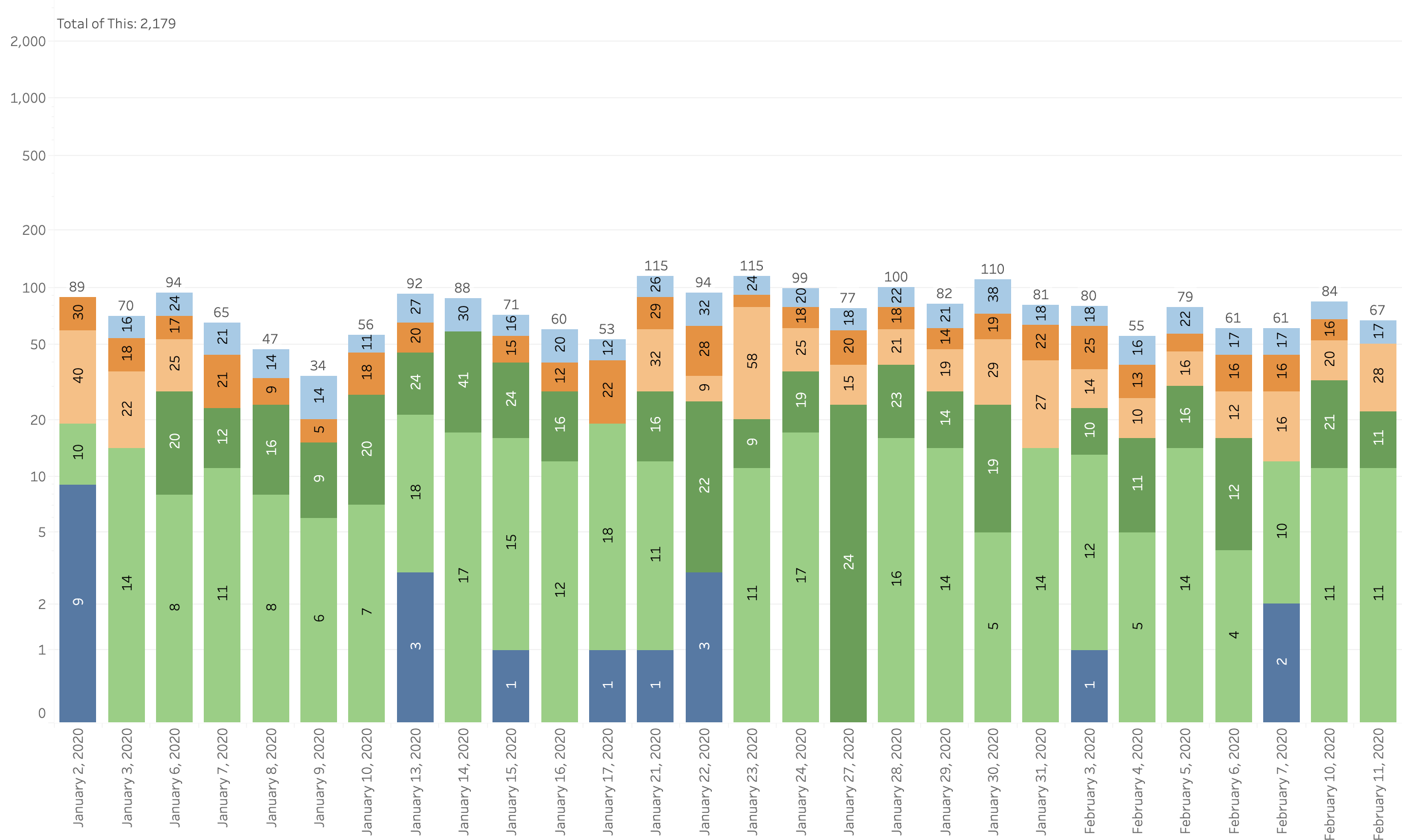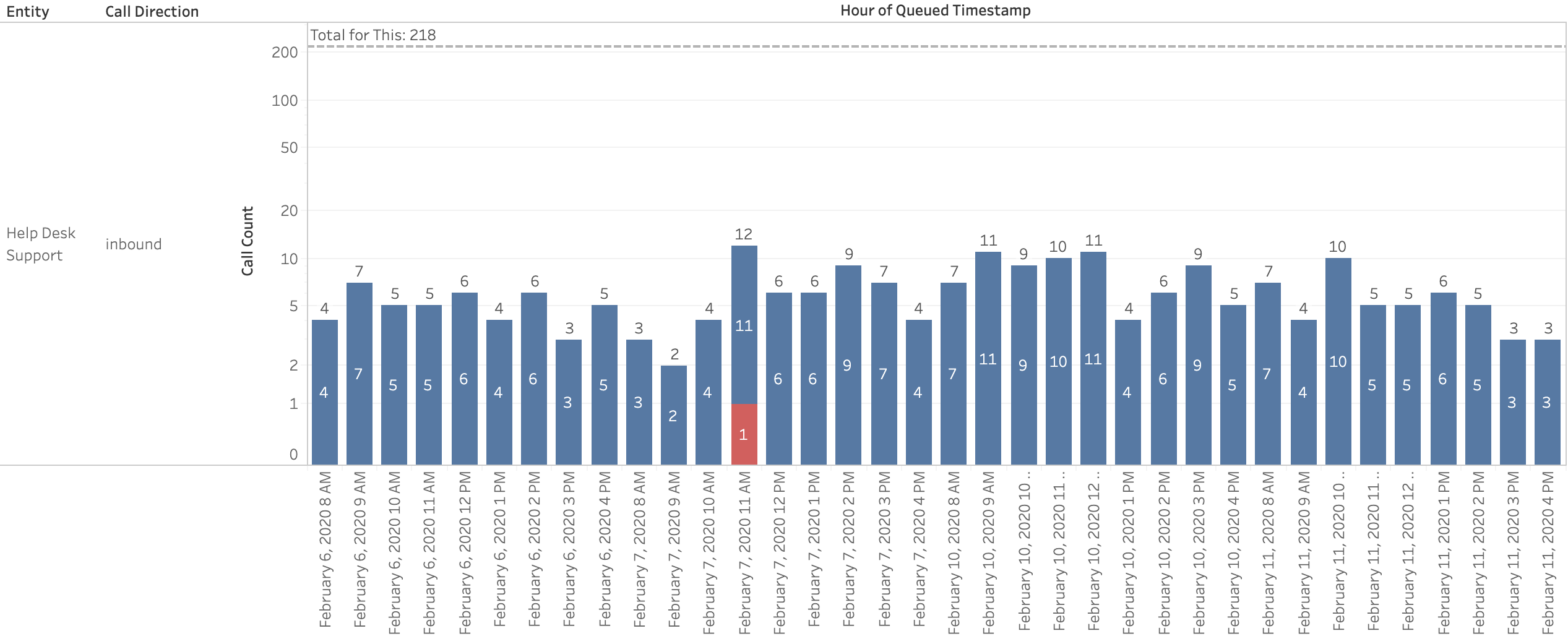The reporting provided standard with NocTel Insight for NocTel Flow constitute the most common KPIs and metrics NocTel natively tracks. Please be aware the definitions used for NocTel Flow metrics and KPIs may differ from other vendors.
| Info |
|---|
Please note that unless otherwise notedstated, each report has both an explicit date range and relative date range counterpart. |
...
| Section |
|---|
| Column |
|---|
| Renders calls taken by the pertinent selected Agent(s) over the specified date interval as a stacked bar chart or tabular format. Hovering over any segment of the individual bars (date grouping) will provide stats relative to that single Agent and the date grouping in the bar chart counterpart. The tabular format forms a hierarchy of Agent=>Queue=>Date Grouping. To summarize the agent calls, it is recommended to simply adjust the date interval Zoom Level until there is one row per agent:queue:date grouping. The calls plotted only factor in calls Agents have answered or placed and do not represent calls the agent was offered but missed. The visualization uses a logarithmic scale on the y-axis to prevent very small values from being imperceptible when plotted with very large values. The Calls Taken field does not distinguish between calls that were offered and answered and calls that were offered but not answered (redirects). |
| Column |
|---|
| 
|
|
Status Activity
...
| Info |
|---|
Agents who neglect to go Offline at the end of their shift may cause erratic data to be rendered. For example, an agent who finishes their shift on a Friday and does not return to duty until the following Monday leaves themselves themself in an Available status. This Available status would be ongoing until the following morning (48+ hours) when they return to duty and take a call from queue. Flow's backend makes no assumptions about agent status durations and will not log status changes until a new status change "closes out" the current status. Therefore, agents who do not manage their statuses properly as well as supervisors who do not recognize or correct this behavior, may result in some report renderings showing excessively long status durations. NocTel will not correct these errors as it . It is your responsibility to manage Agents and their presence. |
...
| Section |
|---|
| Column |
|---|
| Plots Agent call talk time in tabular format. Reports the Average, Shortest, and Longest Talk Times over the date interval and date grouping per Agent. Calls Taken refers to the combined total of both Inbound and Outbound Calls. Calls Taken can be adjusted to only consider Inbound or Outbound calls by changing the Call Direction filter option. Take note that the Average, Shortest, and Longest Talk Times will consider all available calls relative to the Call Direction(s) specified in filtering. This means if both Inbound and Outbound calls are included, then the corresponding talk metrics will include both types of calls. If only Inbound Calls are considered, the corresponding metrics are produced using only Inbound Call data. AHT in this context is synonymous with Average Talk Time. Depending on Call Direction filtering settings, some agents may display NULL values for rows (date groupings). This These should be interpreted as zero values. Heat mapping is applied to the call volume metrics and AHT. The heat mappings only apply column-wise and not overall. Therefore, Calls Taken heat mapping only concerns itself with all values found in rendered rows along the Calls Taken column. Heat mapping cannot be applied to the Talk Time metrics. Note the option to select the <Abandoned> agent, which is a pseudo-agent used by the Flow system to capture callers who were in queue that hung up before speaking to an agent. The <Abandoned> agent's calls are optionally included to provide consistency in regard to total number of calls that reached Queues. Without the <Abandoned> agent being accounted for, reports that center around Agent behavior and performance will not add up to reporting based on the Queue perspective. |
| Column |
|---|
| 
|
|
...
| Section |
|---|
| Column |
|---|
Plots call volume as a stacked bar chart, line plot, or tabular format. Date groupings can be adjusted to be highly granular or coarse depending on need providing detailed or summary reporting. Handling Disposition for filtering indicates what ultimately became of a call. Agent Hungup (Outbound) indicates an outbound placed call that has ended normally, Normal clearing indicates an inbound call from Queue that was answered and hung up normally by the handling agent, and Caller Abandoned indicates calls in which callers were placed in Queue waiting for an available Agent but hung up before any Agent became available. The stacked bar chart and line plot counterparts will always render Call Volume per Queue on separate plots. These visualization styles are intended to be used for side-by-side comparative analysis of Call Volumes. Hovering a cursor over any point on these visualizations will bring up associated metrics corresponding to that particular point (e.g.: the day, week, etc. - however the date groupings are set per zoom level). Use the tabular format best representation of overall totals. Overall total for the entire date interval specified will be rendered. Bear in mind this will cause the y-axis to adjust accordingly. |
| Column |
|---|

|
|
Call Transfers
| Section |
|---|
| Column |
|---|
Reports in tabular format the originating Queue a call arrived from or was placed out of that resulted in a Call Transfer by the Agent. The transfer destination - either as an existing Flow Directory entry or as an unknown number - is listed along with the number of times call transfers have been placed to the destination. This report is intended to help Supervisors and Managers in contact centers identify additional phone numbers to add to their Flow Directory in order to help save Agents time dialing the transfer destination number and potential human error. If an Agent transfers their caller, there is a probability of human error resulting in the caller being sent to the completely wrong place. Calls that are transferred to destinations that are not Flow Queues are captured here. Call transfers between Flow Queues are not tracked. |
| Column |
|---|
 Image Added Image Added
|
|
Raw Calls
| Section |
|---|
| Column |
|---|
Reports in tabular format the raw details of calls reaching Flow from NocTel Talk. Please take careful note that calls reported here are only calls that have successfully reached a Flow Queue. For example, if an organization uses a call menu (IVR) to prompt a caller to press 1 for English or 2 for Spanish then route the caller to the appropriate Queue based on their selection; callers who press 1 or 2 and then are transferred to NocTel Flow from NocTel Talk will be counted in this report as the call has successfully moved between services. Callers who hang up without pressing anything are not included in this report by virtue the caller did not complete the necessary handling steps to transition handling from NocTel Talk to NocTel Flow. Further discussion of this distinction is beyond scope of this documentation - please refer to the NocTel Talk and NocTel Flow documentation spaces. Calls captured here are not processed on any aggregation and report only metrics relevant to each individual call in isolation. This report is intended to provide the equivalent raw data of calls reaching NocTel Flow to enable end users to perform their own further analysis beyond what is provided standard or requested custom. Customers using NocTel Insight who have users or operations spread across different timezones have the ability to select the timestamp localization. For those who prefer a standardized timestamp, Coordinated Universal Time (UTC) is also an option. Each row corresponding to a single call will report on the duration of time the caller waited in Queue before speaking to an available Agent, how long the Agent spoke with the caller, and if the caller abandoned while in Queue how long the caller waited before hanging up. Each of these metrics is measured in seconds. Queued Duration specifically pertains to when the caller has first been placed into Queue up to when the caller is presented to an available Agent. Talk Time specifically pertains to when the Agent answers an offered call up to when the Agent either hangs up or transfers the caller elsewhere. Therefore, the overall lifetime of the call should be considered Queued Duration plus Talk Time or Wait Time to Abandon depending on whether the call was answered or abandoned. |
|
 Image Added
Image Added




